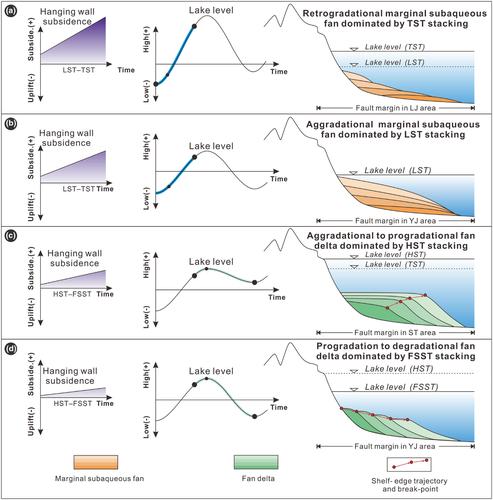当前位置:
X-MOL 学术
›
Basin Res.
›
论文详情
Our official English website, www.x-mol.net, welcomes your
feedback! (Note: you will need to create a separate account there.)
Variability of sequence architecture in a rift margin controlled by tectonic activity: The Eocene Dongying Depression, Bohai Bay Basin, China
Basin Research ( IF 2.8 ) Pub Date : 2024-06-10 , DOI: 10.1111/bre.12876 Rongheng Tian 1, 2 , Benzhong Xian 1, 2 , Jianping Liu 3 , Qianran Wu 1, 2 , Naveed Ur Rahman 1, 2 , Peng Chen 1, 2 , Qian Li 4 , Zhen Wang 5 , Sirui Chen 1, 2 , Jingqiang Yu 6 , Yuzhi Li 6 , Wenmiao Zhang 1, 2
Basin Research ( IF 2.8 ) Pub Date : 2024-06-10 , DOI: 10.1111/bre.12876 Rongheng Tian 1, 2 , Benzhong Xian 1, 2 , Jianping Liu 3 , Qianran Wu 1, 2 , Naveed Ur Rahman 1, 2 , Peng Chen 1, 2 , Qian Li 4 , Zhen Wang 5 , Sirui Chen 1, 2 , Jingqiang Yu 6 , Yuzhi Li 6 , Wenmiao Zhang 1, 2
Affiliation

|
Sequence architectures along the margins of rift basins are still poorly documented compared to passive continental margin settings. The Eocene Shahejie Formation on the rift margin of the Dongying Depression records a complex sequence stratigraphic distribution of conglomerate, sandy conglomerate, sandstone and mudstone. These facies have been mainly attributed to fan delta and marginal subaqueous fan depositional settings that developed during segmented fault activity along the rift margin. We utilize three-dimensional (3D) seismic data, conventional cores, and wireline log data to dissect the overall wedge-shaped upper sub-member strata of the Shahejie Formation's fourth member. The study interval is a third-order sequence formed between 45.4 and 42.5 Ma and contains a lowstand–transgressive systems tract (LST–TST) and a highstand systems tract–falling-stage systems tract (HST–FSST). We found that the LST–TST developed several huge amalgamated depocenters along the Chennan border fault; whereas, these depocenters gradually diminished or even disappeared during the HST–FSST period, illustrating less significant control by the border fault. Through calculations of strata growth rates, we confirmed that the segmented activity of the border fault influences the stratigraphic distribution and facies evolution during these two periods. Specifically, deep-water depositional systems, represented by marginal subaqueous fans were widely developed in the LST–TST period and were influenced by overall strong tectonic activity, including retrogradational (R) and aggradational (A) patterns. However, the aggradational to progradational (AP) deltas and progradational to degradational (PD) deltas dominated the generally muted tectonic activity setting during the HST–FSST. Additionally, influenced by localized segmented fault activity, these systems tracts exhibit incomplete vertical development, resulting in spatial variability in stratigraphic stacking patterns.
中文翻译:

构造活动控制的裂谷边缘层序结构变化:渤海湾盆地始新世东营凹陷
与被动大陆边缘环境相比,沿裂谷盆地边缘的层序构造的记录仍然很少。东营凹陷裂谷边缘始新统沙河街组记录了砾岩、砂砾岩、砂岩、泥岩的复杂层序地层分布。这些相主要归因于沿裂谷边缘分段断层活动期间发育的扇三角洲和边缘水下扇沉积环境。我们利用三维(3D)地震数据、常规岩心和测井数据来解剖沙四段整体楔形上亚段地层。研究层段为形成于45.4~42.5Ma之间的三级层序,包含低位-海侵体系域(LST-TST)和高位体系域-落陷体系域(HST-FSST)。我们发现LST-TST沿辰南边界断层发育了几个巨大的合并沉积中心;而在HST-FSST期间,这些沉积中心逐渐减少甚至消失,说明边界断层的控制作用减弱。通过地层生长速率的计算,我们证实了边界断裂的分段活动对这两个时期的地层分布和相演化的影响。具体而言,以边缘水下扇为代表的深水沉积体系在LST-TST时期广泛发育,并受到整体强烈构造活动的影响,包括退积(R)和加积(A)模式。然而,进积到退化(AP)三角洲和进积到退化(PD)三角洲主导了HST-FSST期间普遍温和的构造活动背景。 此外,受局部分段断层活动的影响,这些体系域表现出不完全的垂直发育,导致地层堆积模式的空间变异。
更新日期:2024-06-10
中文翻译:

构造活动控制的裂谷边缘层序结构变化:渤海湾盆地始新世东营凹陷
与被动大陆边缘环境相比,沿裂谷盆地边缘的层序构造的记录仍然很少。东营凹陷裂谷边缘始新统沙河街组记录了砾岩、砂砾岩、砂岩、泥岩的复杂层序地层分布。这些相主要归因于沿裂谷边缘分段断层活动期间发育的扇三角洲和边缘水下扇沉积环境。我们利用三维(3D)地震数据、常规岩心和测井数据来解剖沙四段整体楔形上亚段地层。研究层段为形成于45.4~42.5Ma之间的三级层序,包含低位-海侵体系域(LST-TST)和高位体系域-落陷体系域(HST-FSST)。我们发现LST-TST沿辰南边界断层发育了几个巨大的合并沉积中心;而在HST-FSST期间,这些沉积中心逐渐减少甚至消失,说明边界断层的控制作用减弱。通过地层生长速率的计算,我们证实了边界断裂的分段活动对这两个时期的地层分布和相演化的影响。具体而言,以边缘水下扇为代表的深水沉积体系在LST-TST时期广泛发育,并受到整体强烈构造活动的影响,包括退积(R)和加积(A)模式。然而,进积到退化(AP)三角洲和进积到退化(PD)三角洲主导了HST-FSST期间普遍温和的构造活动背景。 此外,受局部分段断层活动的影响,这些体系域表现出不完全的垂直发育,导致地层堆积模式的空间变异。

































 京公网安备 11010802027423号
京公网安备 11010802027423号